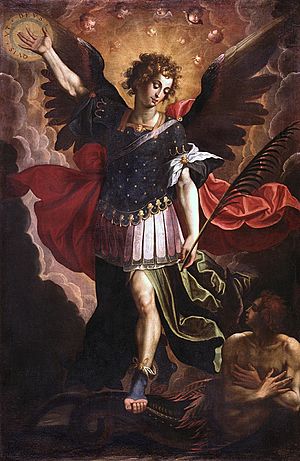Cristóbal Vela facts for kids

Quick facts for kids
Cristóbal Vela
|
|
|---|---|
| Nationality | Spanish |
| Occupation | Baroque painter and gilder |
Cristóbal Vela (around 1588–1658) was an important Spanish artist. He was a Baroque painter and a gilder. A gilder is someone who applies a thin layer of gold, often to sculptures or frames.
Early Life and Training
Cristóbal Vela was born in Jaén, Spain. He started learning to paint in Córdoba, Andalusia, with a teacher named Pablo de Céspedes. Later, he moved to Madrid to finish his art studies. There, he learned from Vincenzo Carducci, another famous artist.
Some people also believe Vela studied in Seville starting in 1610. His art shows influences from the artists in Seville. After his training, Vela worked with art dealers in Seville. He painted many different kinds of artworks for them.
Vela often used the Mannerist style in his paintings. This style uses exaggerated forms and colors. He was also influenced by Naturalism, which means painting things as they look in real life.
Important Works and Career
In 1618, Vela began working on a golden altarpiece for the San Anton church. An altarpiece is a piece of art, often painted or carved, that stands behind the altar in a church. The next year, in 1619, he was asked to create another altarpiece for a client in Campillo de Arenas.
By 1627, Vela was working in Priego. Some of his oldest paintings that we still have today are in the parish church there. These include altarpieces of Saint Peter and Our Lady of the Rosary. In Priego, he married Catherine Garrido. Their son, Antonio Vela Cobo (1629–1675), also became a painter, sculptor, and gilder.
Around 1635, Vela moved to Córdoba. He continued his work as a painter and gilder, especially on altarpieces and sculptures. In 1645, he won a competition to paint altarpieces for the famous Mosque–Cathedral of Córdoba. This was a big achievement for him.
Vela's most famous paintings are found in the San Agustín de Córdoba church. Many of his paintings of archangels are now in the Fine Arts Museum of Córdoba and the Santa Marina church. Other well-known works include paintings for the upper choir of San Agustín. He also created a series of prophet paintings for the convent of St. Augustine.
Later Life and Legacy
Cristóbal Vela passed away in 1658. He had an accident at his home and drowned after falling into a well. After his death, his son Antonio took over his art workshop.
Sadly, many of Vela's artworks are now lost. Others have been damaged over time, sometimes by poor restoration work. Despite this, his remaining works show his talent as a Baroque painter and gilder.
See also
 In Spanish: Cristóbal Vela para niños
In Spanish: Cristóbal Vela para niños

